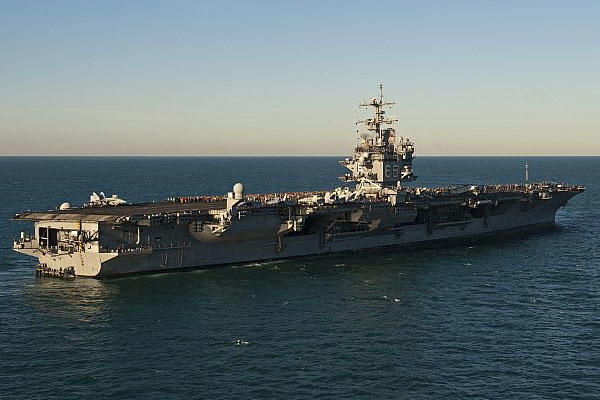NEWPORT NEWS, Va. -- Sailors and Huntington Ingalls Industries shipbuilders are making significant progress with the "de-fueling" and "inactivation" of the USS Enterprise (CVN 65) at the shipyard here.
Following the de-fueling of the ship's eight nuclear reactors, the ship will be formally turned over to the Navy for dismantling by 2016. Huntington Ingalls is currently working under a $745 million contract for inactivation of the USS Enterprise.
The Enterprise completed its final deployment in November 2012 after cruising nearly 81,000 miles on the 238-day deployment to the Persian Gulf in support of operations in Afghanistan.
Also known as "Big E," the Enterprise was the first nuclear-powered aircraft carrier. It was commissioned in 1961 and deployed shortly thereafter as part of the blockade during the 1962 Cuban Missile Crisis.
The ship will be de-fueled and then towed around the tip of South America on its way to Puget Sound Naval Shipyard and Intermediate Maintenance Facility, Wash., Navy and HII officials explained.
The de-fueling process involves removing materials and shutting down the reactors in order to "button up the ship" and get it ready for transport, said Ken Mahler, vice president of Navy programs at Huntington Ingalls Industries.
"Essentially, you've got fuel in these reactors. Everything the workers need to do to get that fuel off they will actually practice in a training and qualification program," Mahler explained.
Once at the Puget Sound Naval Shipyard, the historic ship will be dismantled. However, various parts may be saved for posterity or sent to various museums, officials said.
Overall, the inactivation process will take up to four years. It will involve the draining of the hydraulic systems, fuel tanks and other fluids. In addition, any hazardous materials will be removed and the ships electrical system and lighting will be de-energized, Navy officials said.
"One of her first things was service during the Cuban Missile Crisis," said Rear. Adm. Tom Moore, the Navy's program executive officer for Carriers, who served on the USS Enterprise from 1990 to 1994. "She was still the fastest carrier we had when she retired. Her hull was unique and she could really go."
Able to reach speeds in excess of 30 knots, the USS Enterprise diverted course following the terrorist attacks on September 11, 2001 and steamed through the oceans toward the North Arabian Sea to support Operation Enduring Freedom.
The first of its kind nuclear-powered carrier initially used eight nuclear reactors, an effort which was streamlined to two nuclear reactors after the Nimitz-class carriers burst onto the scene in the 1970s. Prior to the USS Enterprise (CVN 65), submarines were the only nuclear-powered warships.
"The Enterprise had eight reactors. The design was very complex and pieced together based on submarines. Of course, we evolved that," Moore said.
The USS Enterprise (CVN), which formally retired from service in December of last year, is part of a lasting and sentimental legend. It is the eighth ship to bear the name Enterprise. The ship's immediate predecessor, USS Enterprise (CV 6), was a World War II carrier commissioned in 1936.
CV 6 served in the historic and impactful battle of Midway in the Pacific. One of only three U.S. carriers to survive the war, the CV 6 also received the nickname the "Big E."
The legacy and name will live on. The third carrier in the new Ford-class of nuclear powered aircraft carriers, CVN 80, will also be named the USS Enterprise. CVN 80 is slated to enter service by 2027.
"I’m happy CVN 80 will be named Enterprise so we will keep the legacy going," Moore said.



























